The Air Ride Adaptive Suspension available on the redesigned 2021 Tahoe/Suburban and Yukon/Yukon XL is an automatic level control suspension with a variable rate spring design. (Fig. 11)
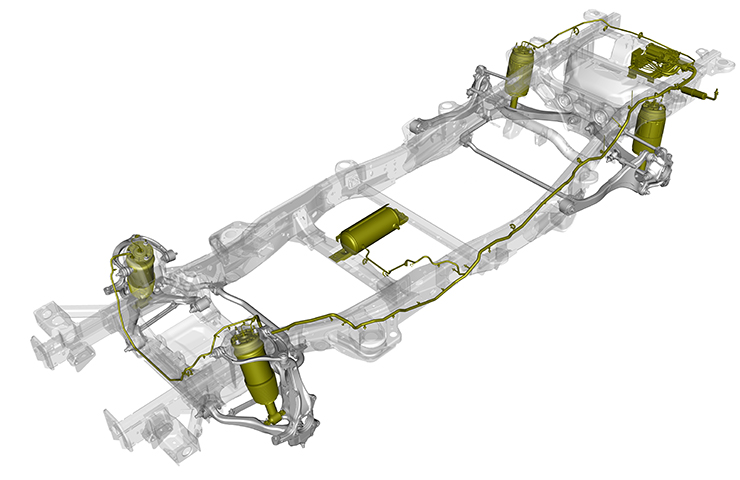 Fig. 11
Fig. 11
The Air Ride Adaptive Suspension has automatic load-leveling and up to 4 inches (100 mm) of ride-height adjustment. It can lower to make it easier to enter and exit the vehicle and lower automatically on the highway to improve aerodynamics and fuel efficiency. Drivers also can raise ride height in off-road conditions for more ground clearance.
The K5 automatic level control module controls the system functions and monitors the suspension system for proper operation. In addition to the driver-selected ride height, the control module uses the following vehicle parameters to establish a target ride height:
- vehicle speed
- lateral acceleration
- longitudinal acceleration
- throttle position
- cruise control status
- transmission range selection status
- stability control system status
- semi-active damping system status
- vehicle power mode
- suspension position sensors
- air spring pressures
System Components
The airflow to the four air springs is determined by the pneumatic control unit, which contains the pressure sensor and control solenoid valves for each spring. The pneumatic control unit, along with the automatic level control module and air compressor, are located above the spare tire under the rear of the vehicle. System components (Fig. 12) include:
- Air Suspension Compressor
- Air Dryer Assembly
- Automatic Level Control Module
- Pneumatic Control Unit
- Air Intake Muffler
- Air Intake Port
- Air Intake Particulate Filter
- Exhaust Air Vent
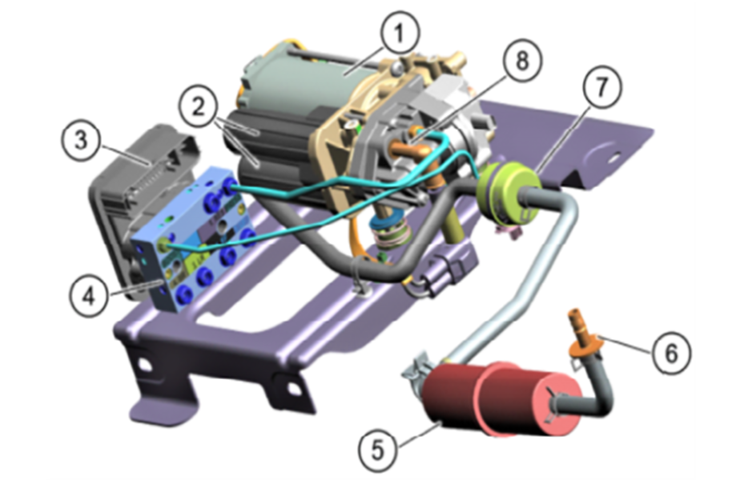 Fig. 12
Fig. 12
The air compressor is a dual-stage, positive displacement, piston air pump with boost mode driven by a 12-volt DC permanent magnet motor. The air compressor draws air from the atmosphere through the air intake or reservoir and supplies the air to the pneumatic control unit. The air dryer removes moisture from the intake air, which is stored in the air suspension reservoir.
Air Springs
The four air springs (Fig. 13, #1) raise or lower vehicle height based on the automatic level control module inputs, which determines vehicle height. The position sensors (Fig. 13, #2) send a pulse-width-modulated signal that corresponds to the current height of the vehicle.
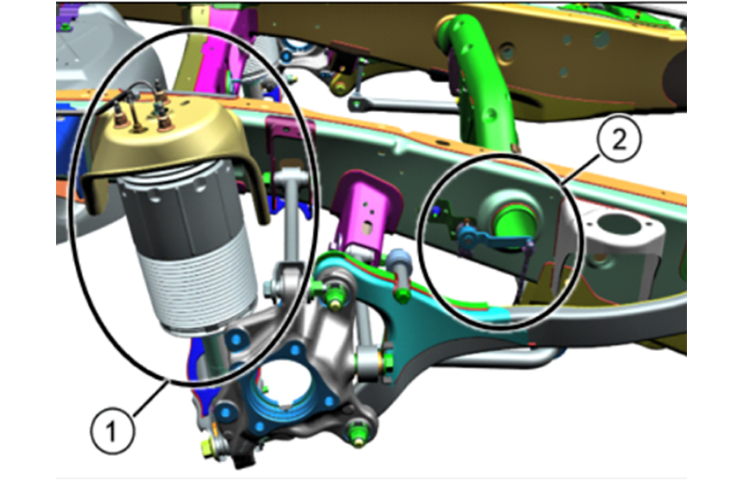 Fig. 13
Fig. 13
Driver Controls
The driver control system enables four different ride heights to be selected. The selected mode is shown on the Driver Information Center. (Fig. 14)
Entry/Exit Ground Clearance – Lowers the vehicle for entry and exit.
Normal Ground Clearance – Standard vehicle height for normal driving
Increased Ground Clearance – Raises the vehicle 1 inch (25 mm) from Normal (4WD HI)
Maximum Ground Clearance – Raises the vehicle 2 inches (51 mm) from Normal (4WD LO)
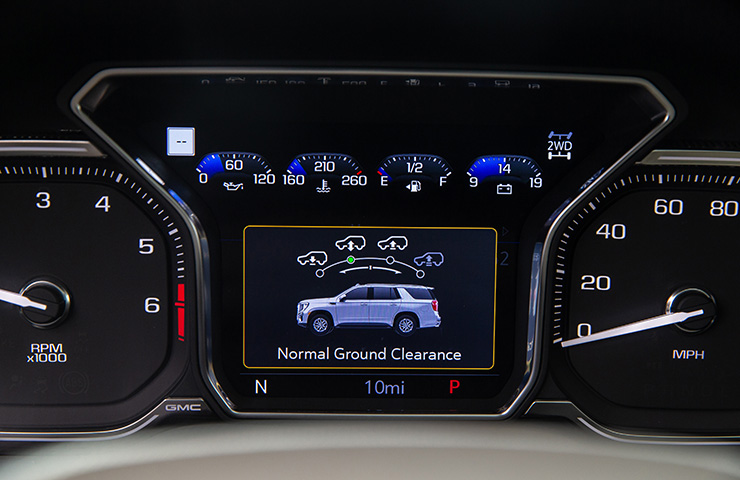 Fig. 14
Fig. 14
TIP: Heavy use of the air suspension may cause the system to temporarily suspend all height changes to allow the air compressor to cool down.
Aero mode, which lowers the vehicle automatically when vehicle speed exceeds 65 mph (105 km/h) for a period of time, cannot be user selected.
Increased Ground Clearance mode can be driver-selected or, when Off-Road mode or Terrain mode is active, ground clearance is increased automatically by 1 inch (25 mm).
Entry/Exit mode can be programmed to lower the vehicle automatically in the Settings menu on the infotainment screen. The vehicle must be in Park and a door opened in order for the air suspension to activate automatically. Lowering the vehicle 2 inches (51 mm) to the entry/exit position takes approximately 8 seconds.
The Entry/Exit mode does not operate when Tow/Haul mode is active, the Off-Road driver mode is active, or a trailer is attached to the vehicle.
Service Mode
When the air suspension system is in service mode, all air suspension operations, including raising and lowering the vehicle and air compressor operation, are disabled. Service mode is useful when the vehicle is being towed on a flat bed or during vehicle service when the vehicle is placed on the hoist.
Service mode is automatically enabled when the vehicle is raised on a hoist or a floor jack. Service mode automatically disables when vehicle speed exceeds 10 mph (16 km/h). Service mode also can be manually enabled and disabled in the Settings menu by selecting the Suspension option. (Fig. 15)
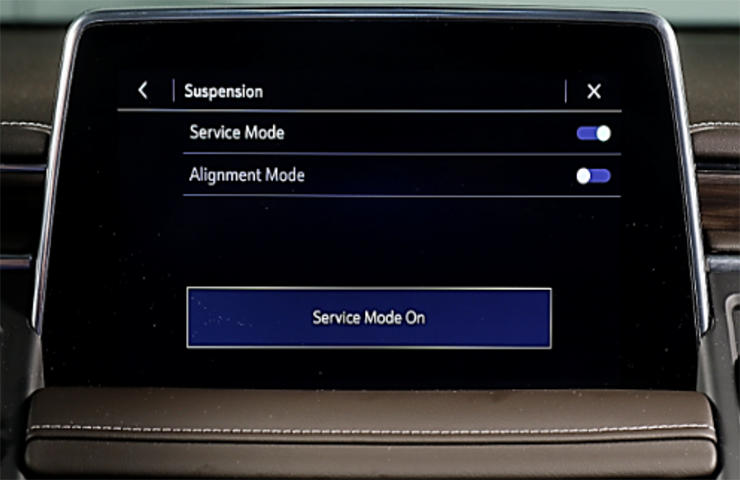 Fig. 15
Fig. 15
TIP: If the vehicle automatically enters suspension service mode, the vehicle must be driven at a speed of 10 mph (16 km/h) to disable service mode, or manually disable service mode using GDS2.
Alignment Mode
Alignment mode optimizes the vehicle height to provide the most accurate wheel alignment. Enable this mode when the vehicle is driven onto the alignment rack.
To enable alignment mode, select the Normal ride height and shift the vehicle into Neutral. Alignment mode automatically disables when vehicle speed exceeds 10 mph (16 km/h). Alignment mode also can be manually enabled and disabled in the Settings menu by selecting the Suspension option.
For much more information on the all-new 2021 Tahoe/Suburban and Yukon/XL, refer to Bulletin #20-NA-137.
– Thanks to Hassan Abdallah and Tom Renno


















